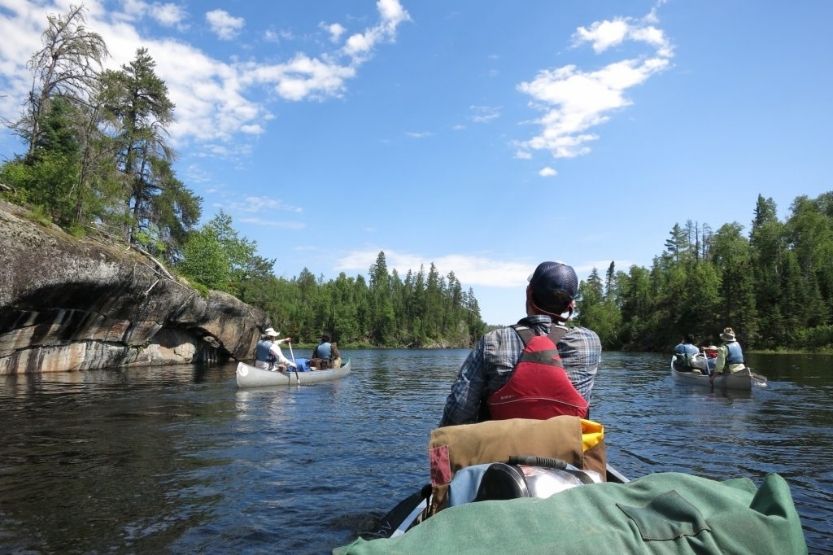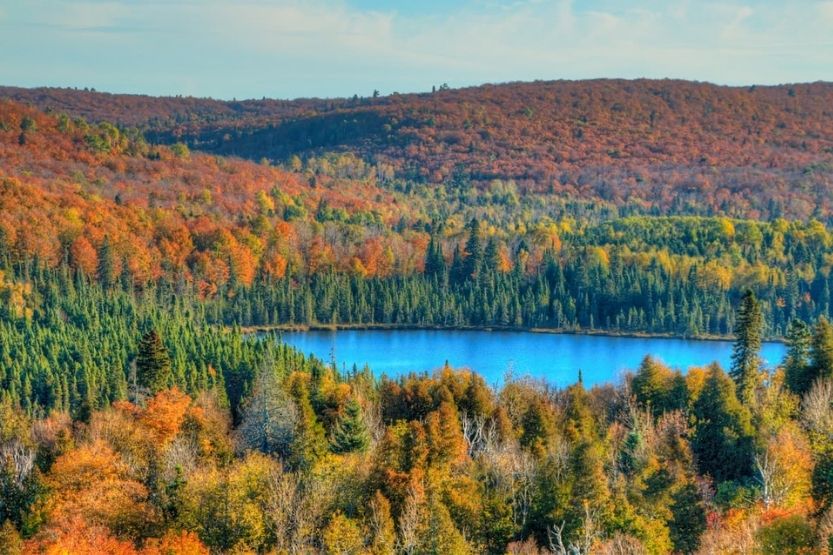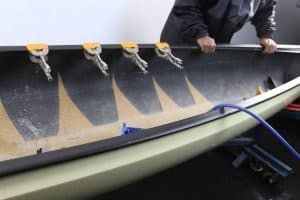The Boundary Waters Canoe Area Wilderness attracts more than 250,000 visitors each year. It is one of the most popular places in the U.S. to canoe, kayak, and hike. If you haven’t gone there yet, you need to experience the Boundary Waters Canoe Area Wilderness.
The Boundary Waters Canoe Area Wilderness is a wilderness area covering around 1,090,000 acres. It is located within the Superior National Forest in Minnesota, USA, particularly in its northeastern part. This place is popular for backpacking, fishing, canoe touring, and other types of wilderness activities.
This wilderness area attracts hundreds of thousands of people each year because of its beautiful and unique attractions. The U.S. Forest Service is administering it. The Boundary Waters Canoe Area Wilderness offers 12 different trails for hiking, 1,200 miles of canoe routes, and 2,000 backcountry campsites.
Read on to learn more about the Boundary Waters Canoe Area Wilderness, what it is, what it offers, its most popular routes and the required permits.
Boundary Waters Canoe Area Wilderness

The Boundary Waters Canoe Area Wilderness is an outdoor attraction located within the Superior National Forest. It covers a total of 1,090,000 acres in the northeastern part of Minnesota, USA. The U.S. Forest Service is administering the place.
12 Hiking Trails
Every year, approximately 250,000 people flock to this place to experience its pristine beauty and unique attractions. This place is trendy for fishing, canoeing, backpacking, dog sledding, and canoe touring. There are 12 various hiking trails in this place where you can experience its outdoor character.
The place was established as a wilderness attraction in 1978. In the past, massive glaciers have formed the area’s unique physical features. These glaciers gouged and scraped the rocks into the distinctive shapes we see today.
Rock Formations, Rugged Cliffs, and More
This area has towering rock formations, rugged cliffs, rocky shores, canyons, sandy beaches, and gentle hills. The place is also surrounded by forest and has thousands of streams and lakes that abound much fish.
To protect and preserve its rugged beauty, the Boundary Waters Canoe Area Wilderness was set aside in 1926. Then in 1964, it was included in the National Wilderness Preservation System, which was subsequently supported by legislation.
Inside the Boundary Waters Canoe Area Wilderness, you are allowed to camp, canoe, and portage, just like what the travelers from centuries ago have experienced. If you want to experience expansive solitude, get connected with nature, and face nature’s challenges, this is where you need to go.
Things You Can Do at the Boundary Waters Canoe Area Wilderness
With more than 1 million acres, the Boundary Waters Canoe Area Wilderness has many wilderness activities to offer. Some of the most popular outdoor activities that visitors in this place engaged in are canoeing, hiking, night sky viewing, and fishing:
1. Canoeing
The most popular way that visitors explore this wilderness area is by canoeing. A study conducted in 2007 revealed that over 94% of people who visited the place overnight used a canoe or a non-motorized boat to explore the area.
The enormous size of the place and its many rivers, lakes, portage trails, and campsites allow for countless different routes. If you don’t know the perfect place to start, there are guidebooks and online maps that suggest possible routes based on entry points, degree of difficulty, and the travel duration.
2. Hiking
Inside this wilderness, space is various hiking trails. This place has short trails and long trails. Among the short trails, the Eagle Mountain trail is very popular. It has a total length of 7 miles or 11 kilometers.
The Border Route Trail running from east to west is one of the longest hikes you can make. Its total length is about 65 miles or 105 kilometers. This trail starts at the northern end of the Superior Hiking Trails. The trail follows through cliffs and ridges in the west. It finally ends when the trail connects to the Kekekabic Trail.
The Kekekabic Trail is another long hike consuming around 41 miles or 66 kilometers. It starts at the Gunflight Trail and continues through the middle of the Boundary Waters Canoe Area Wilderness before it ends near Snowbank Lake. The Kekekabic Trail and the Border Route Trail are part of the much longer North Country National Scenic Trail.
There are also several loop trails in this wilderness area. They include the Sioux-Hustler Trail, the Snowbank Trail, and the Pow Wow Trail.
3. Night Sky Viewing
A fairly recent development in this remote nature place is its designation as a Dark Sky Sanctuary in 2020. It is only one of 13 such sanctuaries on the planet. The U.S. Forest Service has been working for this designation since 2008.
According to the USFS, this designation proves what visitors in the area have enjoyed for thousands of years. Starry nights, dark skies, and amazing displays of northern lights were always a part of the wilderness experience offered by this place before it earned this distinction.
4. Fishing
With the many lakes, rivers, and streams in the area, it is not surprising that fishing would be one of the things visitors enjoy doing in the Boundary Waters Canoe Area Wilderness (BWCAW). There is plenty of game fish that recreational fishers can catch in BWCAW.
Some of the species you can catch in the waters of this place are smallmouth bass, largemouth bass, walleye, northern pike, and panfish. Many types of trout flourish in these waters. You can catch rainbow trout, lake trout, splake, and brook trout if you are lucky.
Other species like whitefish, burbot and white sucker also populate this wilderness place’s rivers, streams, and lakes. These waters harbor one of the biggest concentrations of native lake trout among the 48 states in the country.
Boundary Waters Canoe Area Routes

With so huge an area, choosing where to start in the Boundary Waters Canoe Area Wilderness is daunting. There are the usually favored entry points, and there are spots that fewer people have tried. It is even more difficult to choose the portage trails, ponds, rivers, and lakes that your route will include.
To help you decide, I will suggest four loops (or loop-like routes) that experienced visitors of the Boundary Waters Canoe Area Wilderness have used. The duration of these canoe trips or routes can range from four to six days. When it comes to difficulty, they offer the whole scope.
1. Minnesota’s Mountains
Minnesota has many lakes but not many mountains. But the mountains of Minnesota are beautifully exhibited in this particular route. This route offers great bluffs, huge cliffs, long lakes, and incredible overlooks.
The length of this route is around 50 miles or 80.5 kilometers. It will take about 4 to 6 days to complete this route. The usual entry or starting point is at No. 60, “Duncan Lake.” The exit point is usually at Clearwater Historic Lodge.
Those who want to go fishing while on the route can refer to Fisher Maps F-13 and F-14.
Some highlights of this route are that you will arrive at several small lakes encircled by gorgeous mountains after going through the Baby Grand Portage. Once you portage to Clearwater Lake, don’t forget to turn around. You will be greeted with a stunning view of the Minnesota Mountains.
2. Islands Rivers and La Croix
You will start this route at The Little Indian Sioux River. This river leads to several large bodies of water. The route will finally end at another river called the Moose. You will be traveling around 49 miles. This will take around 4 to 6 days to complete.
The most likely entry point is at No. 14, “Little Indian Sioux River (north).” And then you will exit out at No. 16 “Moose/Portage River.” For recreational fishers, you may want to refer to Fisher Maps F-16 and F-23.
Some highlights of this route include the Devil’s Cascade, which you will encounter on the first day of your trip. This is an amazing display of rock and waterfalls. And then you will come across and experience the water rapids and falls of the Lac La Croix islands.
You are advised to bring your map and compass because you will be tempted to explore the lakes and the islands in the area.
3. Frost River
Since this is the favorite route of Cliff Jacobson, it must offer great things. Cliff is a well-known canoeist, outdoorsman, and author. It could mean that this route is challenging. In that sense, be ready for several portages, stunning lakes, and a tiny intimate stream.
The overall length of this route is around 25 miles or 40.2 kilometers. It will take you around 3 to 5 days to complete this route. You will likely start at No. 50 “Cross Bay Lake” and end at No. 51, “Missing Link Lake.”
If you want to fish, bring your Fisher Map and refer to F-12. One of the highlights of this route is paddling the Frost River, which is an intimate and unique experience. This place is so remote that you will really feel you are hundreds of miles away from civilization.
4. Big Water and Big Portage Loop
This route starts on Fall Lake and then goes north into Basswood Lake. After paddling for two days or more, you will find yourself starting to miss portaging. Then you portage back to Fall Lake.
An alternative way of finishing this route is to continue south up to an old logging road submerged in water and totally grown. This road is also four miles or 6.4 kilometers long. You can try this exit if you are up to it, but it’s not recommended because it is difficult.
The total length of this route is 30 miles or 48.3 kilometers. It will take you from 3 to 5 days to finish. On route, you will see many lakes but not so many portages. This route also has a four-mile portage that you need to bear.
These are only some of the well-traveled routes that explore the beauty of the Boundary Waters Canoe Area Wilderness. If you bring along some maps, you might be able to discover a route that will be more to your liking.
Boundary Waters Canoe Area Permits

Since the Boundary Waters Canoe Area Wilderness is a protected area, you are required to get a permit if you want to experience the place. Permits are required in all seasons. You can reserve your permit from May 1 to Sept. 30.
Permits are also limited by day and by entry point. This is required by the U.S. Forestry Service to reduce the adverse impact on the wilderness area. So, early planning for your trip is essential. After Sept. 30 up to Apr. 30, permit reservations are no longer required. There is no reservation requirement for day-use permits. The day-use permits are also free.
Lotteries for permits are no longer observed. All kinds of permits, including day use motor and overnight canoe/motor permits, are available without lotteries.
General Permit Reservations
All entry point reservations are made on a first-come, first-served basis, starting on Jan. 27, 2021. For convenience, you can ask the help of an outfitter who will outfit your trip and also book your permit. You can get your permit directly from Recreation.gov or by calling phone number 1-877-444-6777.
User Fees
The Boundary Waters Canoe Area Wilderness requires user fees for all overnight visitors between May 1 and Sept. 30. The user fees for each person per trip are as follows:
- Adults – $16.00
- Children/Youth from 0 to 17 years old – $8.00
- Interagency Senior/Access Pass Holders – $8.00
- Interagency Youth/Access Pass Holders – $4.00
Boundary Waters Canoe Area Wilderness Seasonal Fee Card
If you have a Boundary Waters Canoe Area Wilderness Seasonal Fee Card, you already have satisfied the user fee requirements for the season. But you still have to get a BWCAW permit. You can buy the card in person after May 1 from any office of the US Forest Service.
The costs of seasonal fee cards per person are as follows:
- Adults – $64.00
- Children/Youth 0 to 17 years old – $32.00
- Interagency Senior/Access Pass Holders – $32.00
- Interagency Youth/Access Pass Holders – $16.00
Conclusion: Boundary Waters Canoe Area Wilderness
The Boundary Waters Canoe Area Wilderness is a top-rated tourist destination in the United States. It is a wilderness area covering around 1,090,000 acres. This place is located within the Superior National Forest in the northeastern part of the state of Minnesota. It is under the administration of the U.S. Forest Service.
This wilderness place is very popular with those who love to spend time outdoors. Visitors can spend several days canoeing, fishing, hiking, and exploring the place. But there are times that you need to have a permit to be able to enjoy the place.
Related reading:

![Read more about the article Kayak in Wisconsin [Best 17 Places for Kayaking in Wisconsin]](https://boatinggeeks.com/wp-content/uploads/2020/12/kayak-in-Wisconsin-300x200.jpg)

![Read more about the article Canoe in Illinois [Best 16 Places for Canoeing in Illinois]](https://boatinggeeks.com/wp-content/uploads/2020/12/canoe-in-illinois-300x200.jpg)